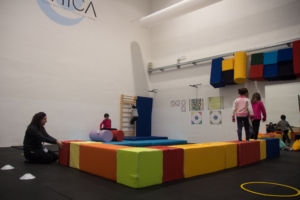Psicomotricità
 La psicomotricità è un’attività che va ad integrare l’esperienza educativa e rappresenta per i bambini un’occasione per parlare di sé, della propria interiorità attraverso il corpo e il movimento che sono le vie privilegiate di espressione.
La psicomotricità è un’attività che va ad integrare l’esperienza educativa e rappresenta per i bambini un’occasione per parlare di sé, della propria interiorità attraverso il corpo e il movimento che sono le vie privilegiate di espressione.
La psicomotricità è un’attività di aiuto alla crescita che agisce sulla globalità del bambino considerando le diverse aree di sviluppo: motoria, cognitiva, relazionale ed emotiva.
Attraverso il gioco spontaneo e il movimento si accompagnano i bambini a vivere e ad esprimere il loro mondo interiore, a prendere contatto con le loro emozioni e a capire chi sono. Il corpo diventa quindi l’elemento centrale, un corpo da sperimentare e da vivere.
È un’attività che utilizza come strumento principale il gioco, serve a favorire uno sviluppo psicomotorio armonico, migliorare la fiducia in sé stessi, l’autostima e il riconoscimento delle proprio emozioni, aiuta a prevenire i disagi negli apprendimenti.
Lo psicomotricista diventa, all’interno del percorso, un compagno di viaggio che interpreta, sostiene e avvalla i percorsi dei bambini.
E’ in questo clima di totale accettazione, di assenza di giudizio e di massima comprensione che i bambini si raccontano, si aprono e acquisiscono fiducia in loro stessi, rispettando le loro unicità e quelle altrui .
Così facendo si favorisce il passaggio dall’agire al pensare e si pongono le basi per apprendere, creare, comunicare e stare con gli altri.
La psicomotricità è un’attività che sostiene la crescita e quindi tutti i bambini possono e dovrebbero fare psicomotricità, anche per i genitori è un’occasione per conoscere meglio e riflettere sul proprio bambino e anche per trovare insieme delle strategie per sostenerlo ed aiutarlo nella crescita.
I percorsi psicomotori sono particolarmente indicati per chi presenta difficoltà o assenza di linguaggio, con problemi di coordinazione, di organizzazione grafica, di manualità fine, o che necessitano di lavorare sull’autoregolazione delle emozioni e su comportamenti problematici
Proposta psicomotoria:
- Percorsi condotti con piccoli gruppi
- Percorsi individuali
- Percorsi genitore bambino/a
- Percorsi di famiglia
- Percorsi con gruppi di adulti per approfondire la conoscenza del proprio corpo attraverso la pratica psicomotoria
- Percorsi per gruppi di lavoro come maestre, educatori…
Psychomotricity
Psychomotricity is an activity that integrates the educational experience and represents an opportunity for children to talk about themselves, their interiority through the body and movement which are the privileged ways of expression.
Psychomotricity is an activity that helps growth and acts on the child by considering the different areas of development: motor, cognitive, relational and emotional.
Through spontaneous play and movement, children are accompanied to live and express their world and to contact emotions and understand who they are. The body thus becomes the central element, a body to be experienced and lived.
It is an activity that uses play as its main tool, it serves to promote harmonious psychomotor development, improve self-confidence, self-esteem and the recognition of one’s emotions, it helps prevent learning disorders. The psychomotor becomes a travel companion who interprets, supports and validates the paths of children.
It is in this climate of total acceptance, absence of judgment and maximum understanding that children tell each other, open and gain confidence in themselves, respecting their uniqueness and those of others. In this way, the transition from acting to thinking is facilitated and the foundations are laid for learning, creating, communicating and being with others.
Psychomotricity is an activity that supports growth, all children can and should do this activity, it can also be useful for parents as it is an opportunity to learn more and reflect on their child and also to find together strategies for support him and help him grow.
Psychomotor paths are particularly suitable for those with difficulties or lack of language, with coordination problems, graphic organization, manual skills, or who need to work on self-regulation of emotions and problematic behaviors.
Psychomotor proposal:
- Paths conducted with small groups
- Individual paths
- Parent child paths
- Family paths
- Path with
- Paths with groups of adults to deepen the knowledge of one’s body through psychomotor practice
- Paths for work groups such as teachers, educators …


